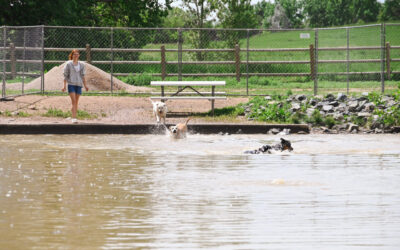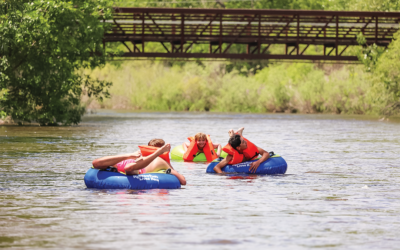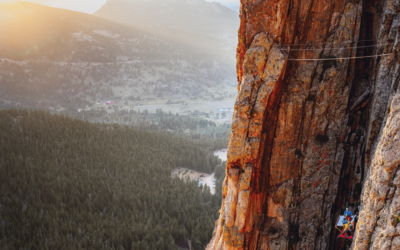Loveland sculptors lent their talents to create a Nebraska monument.
A walk through the Stations of the Cross, at Cloisters on the Platte near Omaha, Nebraska, transcends description. It is a 2,500-foot-long walkway comprised of 14 sculpture stations that represent the final days of Jesus’ life, from his trial through his burial. The monument is arguably the most comprehensive story ever told in bronze. For those of any faith, these dramatic and detailed sculptures can be appreciated for their art.
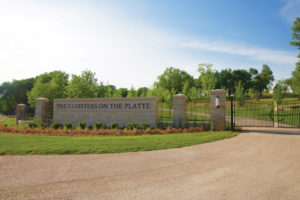
Entry to Stations of the Cross.
Cloisters on the Platte is a multimillion-dollar spiritual retreat developed by TD Ameritrade founder and philanthropist Joe Ricketts; it opened to the public in July.
In 2015, Ricketts commissioned artists Lynn and Jane Kircher of Jaroso, Colorado, to complete 14 stations at life and ¼ size for his religious retreat. The goal would be to complete it in three years—a project of such magnitude could easily take twice that time. Kircher, a friend of Ricketts, was known for his liturgical sculptures. He put together a pool of candidates for this project and selected those who had a reputation for excellent figurative work, and who he knew he could work with toward a common goal.

Station 7: Jesus falls a second time.
Kircher immediately thought of Loveland sculptor George Lundeen, who had a long history of sculpting a variety of monument-sized figures. A Nebraska native, Lundeen is one of the founders of Loveland’s “Sculpture in the Park” show. His and his brother Mark’s bronze statues of American presidents and monumental-sized sports figures can be seen at SCHEELS stores throughout the country.
Lundeen suggested four others he had worked with, knowing they were reliable and talented—Ann LaRose, Joey Bainer, his sister-in-law Bets Lundeen and his brother Mark Lundeen. The team accepted responsibility for six of the 14 stations.
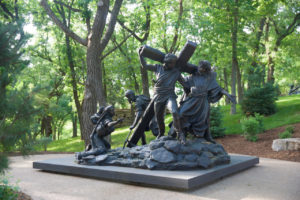
Station 3: Jesus falls the first time.
The project started with a multiday retreat in June 2015 in order to introduce all artists to the Stations of the Cross from a historical standpoint. The group was shown 65 examples of how artists had presented the stations over the centuries. The group planned for theirs to be the largest and best ever done.
During their retreat, the artists presented a wide variety of ideas, but they needed to come up with a consistent medium for their proposal.
“We have too many approaches, from digital to drawings to miniatures done in clay,” Lundeen told his fellow sculptors during the initial phase. “We need to work on a common format.”
life scale models that would be presented to Ricketts for approval. What emerged was one of the most detailed stories ever told in bronze, but it grew from the initial 45 figures to 60.
Typically, artists work in solitude, and sculpting as part of a team was a first for some. Ann LaRose found herself thrust into the group working elbow to elbow, for her a new experience. At 29 years old, Joey Bainer was the youngest artist and was flattered by the fact that fellow seasoned artists took his suggestions seriously.

The Lundeen Studios team.
The artists in Lundeen’s team complemented each other’s work. Lynn Kircher later pointed out that it was a delicate balance to find cohesiveness and yet respect individual style. The final versions were sculpted in clay at ½ life scale incorporating all the design elements. They were later scanned and 3D-printed at larger-than-life size, depicting a seven-foot Jesus.
George Lundeen proudly points out the detail in the clothing and robes. For example, it was written that there was a storm when the body of Christ was lowered from the cross, as captured in Station 13. Even though the figures were cast in rigid bronze, the fabric appears to be blowing from a gust of wind.
Bets Lundeen did in-depth research and created biblical references for each station. What she discovered influenced what went into some of the stations. A young boy with a lamb was added to one station for the reference “lamb of God.” An old woman was added to another station trying to offer Christ water as her child was pulling her away.
When it was time to have the final pieces made, 3D-printing technology was used for foundry molds. This not only saved time but also allowed the artists to sculpt the stations at a smaller scale and enlarge each to its larger-than-life version.
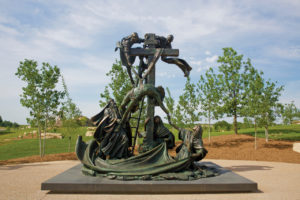
Station 13: Jesus’ body is taken down from the cross.
The entire project was so massive that nine foundries—in Colorado, Oregon and California—were required to cast the many pieces. After the project was installed, Portland sculptor and foundry owner Rob Arps commended the group, and its leader in particular.
“I credit George Lundeen as being possibly the only person that could pull off such a project—one that has required numerous sculptors working together toward a complex goal,” said Arps. “It involved coordinating with different foundries, having various design elements, different styles and making the patina consistent from piece to piece.”
The Lundeen team worked for two and a half years, six days a week, frequently putting in 12-hour days. All five sculptors worked on the stations assigned to them, producing continuity from station to station. The group finished all of their pieces in January, well ahead of the spring 2018 deadline.



